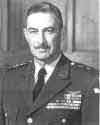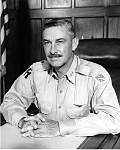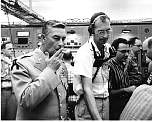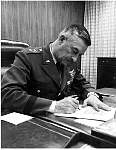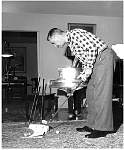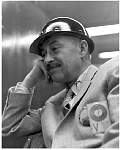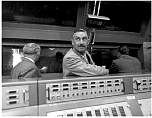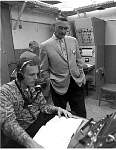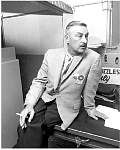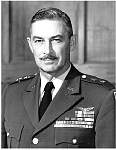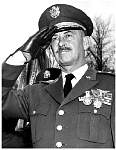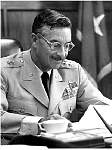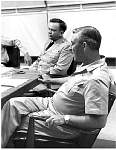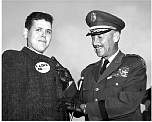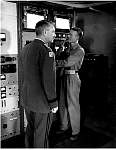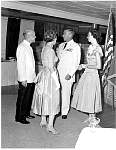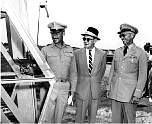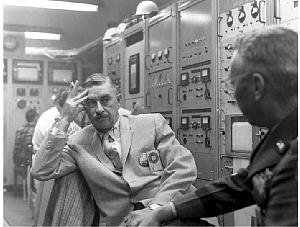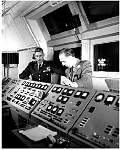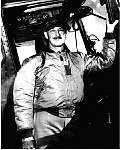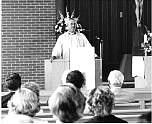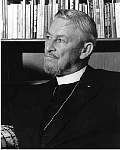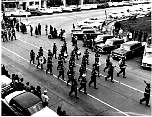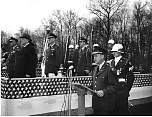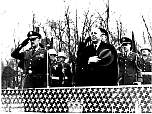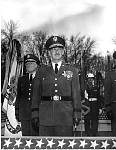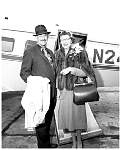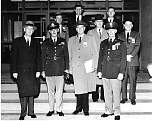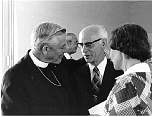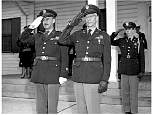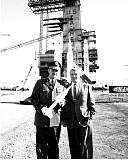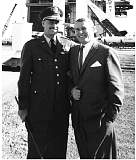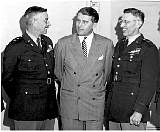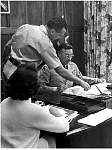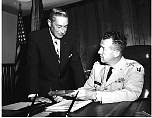MG John B. Medaris
View the MG John B. Medaris photo gallery
Read the remarks of MG (Ret) Medaris in 1978 at a 20th Anniversary Celebration of EXPLORER I
John Bruce Medaris was born in Milford, Ohio, on 12 May, 1902. His service in the Armed Forces began in 1918 when he enlisted in the U.S. Marine Corps. He served in France during World War I and was honorably discharged with the rank of Corporal. Upon his return from Europe at the close of the war, Medaris enrolled at Ohio State University, where he studied mechanical engineering. As Cadet Captain of the Senior ROTC Unit, he won a commission as Lieutenant of Infantry, U.S. Army, in 1921. he served with the 29th and 33rd Infantry Regiments in the United States and Panama until 1926, then was detailed to the Ordnance Corps. He resigned from the Army in October 1927, and for the next 10 years, he was engaged in merchandising and management advisory work in South America and the United States.
Medaris returned to active duty in 1939 as a Captain in the Army Ordnance Corps. During World War II, he served with II Corps in Tunisia and Sicily before joining Headquarters, First Army, whose campaigns included those of Normady, Northern France, the Ardennes, the Rhineland, and Central Europe. Medaris directed the efforts of 20,000 Ordnance troops supporting the combat elements of the First Army; in this capacity, it fell to him to identify the first German V-2 rocket fired against First Army in Europe.
Until November 1955, when he was designated the first Commanding General of the newly created U.S. Army Ballistic Missile Agency (ABMA) at Redstone Arsenal, Alabama, Medaris undertook a variety of ordnance chores. During this period, he was promoted to Major General. On 1 February 1956, Medaris activated ABMA and assumed responsibility for development and production of the JUPITER IRBM missile system as well as the weaponization of the REDSTONE ballistic missile. Under his energetic leadership and forceful direction as head of ABMA, the Army also began its accomplishments in the space arena with the successful launch of the EXPLORER I satellite.
Medaris left ABMA to become the Commanding General of the U.S. Army Ordnance Missile Command (AOMC) on 31 March 1958. His command included ABMA, the Army Rocket and Guided Missile Agency (ARGMA), White Sands Missile Range, the Jet Propulsion Laboratory, and Redstone Arsenal. As AOMC Commander, Medaris was responsible for all Army Ordnance programs in rocket, guided and ballistic missile, and space fields.
During his tour of duty as AOMC Commander, additional EXPLORER satellites as well as the PIONEER lunar probes were successfully launched by the Army, resulting in significant scientific discoveries. The Army also made significant contributions toward the goal of manned space flight by launching into outer space and then recovering two living primates in May 1959. In addition, effort on the SATURN I booster program began in August 1958. The following year, NASA selected the REDSTONE for use in the Project MERCURY development flights; a MERCURY-REDSTONE carried CDR Alan B. Shepard on his historic suborbital flight around the Earth in May 1961.
Medaris retired from the Army on 31 January 1960. His dedicated efforts in the engineering and scientific fields related to guided missile development, as well as his work to create public understanding of the challenges and promises of the Space Age, marked him as one of the nation's leading authorities on the evolving U.S. space program. He was inducted into the Ordnance Corps Hall of Fame in 1972. In 1970, Medaris was ordained an Episcopal priest and lived in North Carolina.
He was honored in May by the National Space Club and the Smithsonian Institution for his vision and leadership in the early days of the space program, as well as for his work in public awareness of the promise of the Space age.
At a ceremony at the National Air and Space Museum, the first MG John B. Medaris Award for Army Achievement in Space was accepted for Medaris by his son, retired LTC John B. Medaris, Jr., of Huntington, N.Y.
MG Medaris died in 1990 and was buried in Arlington National Cemetery.
MG John B. Medaris photo gallery
20th Anniversary of Explorer I
Huntsville-Madison County Chamber of Commerce
January 31, 1978
Mr. Chairman, Governor Wallace, Mayor Davis, General Guthrie, General Rachmeler, and other Distinguished Guests - you will forgive me If I do not again introduce the head table - friends of Huntsville:
I am grateful to the Lord that Mrs. Medaris and I could be with you on this memorable occasion and to express our affection for old friends and the people of this city.
I had only one purpose in mind in accepting your kind invitation.
That was to put the background in perspective In order that the present may be fully understood. The true facts, the foundations for what has been achieved, the entire background have been so obscured by the glamour of the atmosphere created by NASA that It seems almost Impossible to put the ancestry of modern Huntsville Into proper perspective.
I propose in the short time allotted today before you a series of facts in the hope that a sense of perspective may be restored as it should be.
Item 1 - The United States Army was the original proponent of rockets as weapons, and the dedication and insistence of Colonel, later Brigadier General H. N. Toftoy, made it possible through Operation Paper Clip to bring the German rocket team headed by Wernher von Braun out of the confused melee of authority after the Nazi collapse, and give them a "work haven" In the United States at the U. S. Army's Fort Bliss.
Item 2 - The U. S. Army found, protected and shipped to the United States completed V2 rockets, tons of parts and supporting documents for their fabrication and assembly, providing Dr. von Braun and his associates with transitional resources for continuing their work.
Item 3 - The faith of the U. S. Army In the future of rockets and guided missiles fostered and underwrote the move of Mon Braun's team to an almost abandoned Army facility at Huntsville, and thus began the creation of the base of operations that made possible an extraordinary series of achievements.
Item 4 - The United States Army almost literally begged, borrowed and stole money and facilities to support von Braun's technical team and. entered the new field of large-sized guided missiles with nuclear capabilities. The Redstone Missile was the first generation of longer range, accurately guided missiles with large warheads and nuclear capabilities. With the support of the Army much was done with little money. Industry saw no future in this strange business, and the Chrysler Corporation was almost literally blackjacked into accepting the mission of production contractor for Redstone. Thus we were able to move the techniques and capabilities associated with inertially guided ballistic missiles with the range advantage of liquid propellants out of the laboratory and Into production. The Army actually bootlegged money to start construction of the first large test stand that served so well for Redstone and Jupiter. I know because I happened to be the one, then In Washington, who could do it.
Item 5 - The presentation of Project Orbiter failed to be convincing and the mission of launching a satellite in the International Geophysical Year went to Vanguard, an ill-conceived expensive, idealistic project which caused the United States to pay out a pretty penny to help that project reinvent the wheel. At this point the von Braun team had been officially declared "out" of the race for space. We were instructed by highest authority to disclaim any such race.
Item 6 - The United States Army brought all its resources to bear to get a fingertip hold on the future by having allotted to It one leg of the priority defense effort to produce and field an Intermediate range ballistic missile. The Army candidate was Jupiter. A special agency was to be created, and given priority and authority unique in history, to push this project to a successful conclusion. I was called from prospective retirement to head that agency - ABMA. Only the importance and the priority of that agency made it possible to keep a spark of life In Orbiter, the last visible hold of the von Braun team on the doorway to space. By deliberately choosing to use the multi-stage Orbiter configuration as a test bed for a practical solution to the reentry heating problem, hardware could be developed, tested and used properly; productively and economically which lacked only a fourth stage to become a satellite. These tests being necessary to the success of Jupiter, the hardware that later lifted Explorer I had the priority to get on the Atlantic Missile Range in the face of Air Force foot dragging.
Item 7 - The first time I flew into Huntsville to begin the process of setting up the new agency in October, 1955, I could hardly find the place. The green and white beacon of Huntsville Airport rotated in a sea of blackness. At 10 o'clock that night most of the lights in the then tiny area of Huntsville were already dim or out. Only previous notice had the runway lights on to Illuminate the small runway at the Arsenal. The figures say Huntsville had 17,000 people but it did not seem to be that many! The city did not abut the Arsenal and Jordan Lane was a rundown area, ready to be the honky tonk line for a growing military base.
Item 8 - Jim Record's history of what happened is correct, but somewhere the, recognition of the enormous psychological and prophetic push required to make things happen has been lost. I told them what was needed. I begged, coerced, cajoled and threatened. Expansion could not take place without annexation. Unanimity was essential. One sincere young commissioner had been elected on a promise never to approve annexation, without a referendum. After a series of meetings - recognizing the need -I saw him in real tears finally agree that it had to be done at the cost of breaking his word. A trip to Montgomery, an appearance before the State Legislature, and that deed was done. Huntsville's limits were pushed out - far out - so that finally planning for needed sewer and water extensions could proceed decently. Cooperation In zoning kept the red lights away from the Arsenal. There was crowding, people traveled 50 miles to find a place to live. Bankers didn't believe us --- the FHA was stingy with approvals to finance added housing. We met with the bankers, and preached the gospel, of the future to anyone who would listen, who might be able to build some homes. The Army thought I was both conceited and crazy but they did their best under the whip of a high priority national mission.
Item 9 - Before Explorer I talked to the Huntsville-Madison County Chamber' of Commerce and predicted that Huntsville would, be a city of 100,000 in ten years or by 1967. I thought they were going to run me out of town, or send men in white to carry me off. They made that figure by 1963 - four years sooner than I had predicted.
Item 10 - When I see a headline that says, "Marshall Space Flight Center was in from the beginning" I am forced to wonder - when was the beginning? MSFC did not exist until mid 1960 and was then created by a caesarian birth from the womb of the Army. By that time Explorers had been launched into orbit, and into deep space. Another series of space Instruments had been launched by a modified Jupiter. This vehicle was the Juno series as the first had been the Jupiter C series. Huntsville was already above 70,000 people and bursting. A full-scale mockup of Saturn 1, the cluster job, was on hand and fabrication of that version was under way. The safety and reliability of both Redstone and Jupiter were axiomatic so, that the choice of Redstone to make Alan Shepard the first American in space was not only natural but inevitable.
Item 11 - Wernher von Braun was a loyal subordinate and became my very good friend. On more than one occasion he expressed the wish that he still had the operational team of the Army above him and in front of him, running interference and keeping the string from coming untied. I would take nothing from the glory that is due Wernher von Braun and his loyal group of scientists and engineers for the technical Imagination, the innovative courage, and the confidence of success that took them always forward on the cutting edge of the state of the art, but I do choose to remind the historians' of Huntsville that the Army led this city from cotton and watercress to become the Space Capitol of the United States, that the Army payroll here is continuously greater than that of NASA, that the failure of nerve and of Imagination on the part of NASA's administration has led us into a decade of non-achievement in space, and that only by the mercy of God Almighty may we, as a nation, avoid the traps dug for us by the fearful, the weak, and the selfish to have what it takes to move forward.
